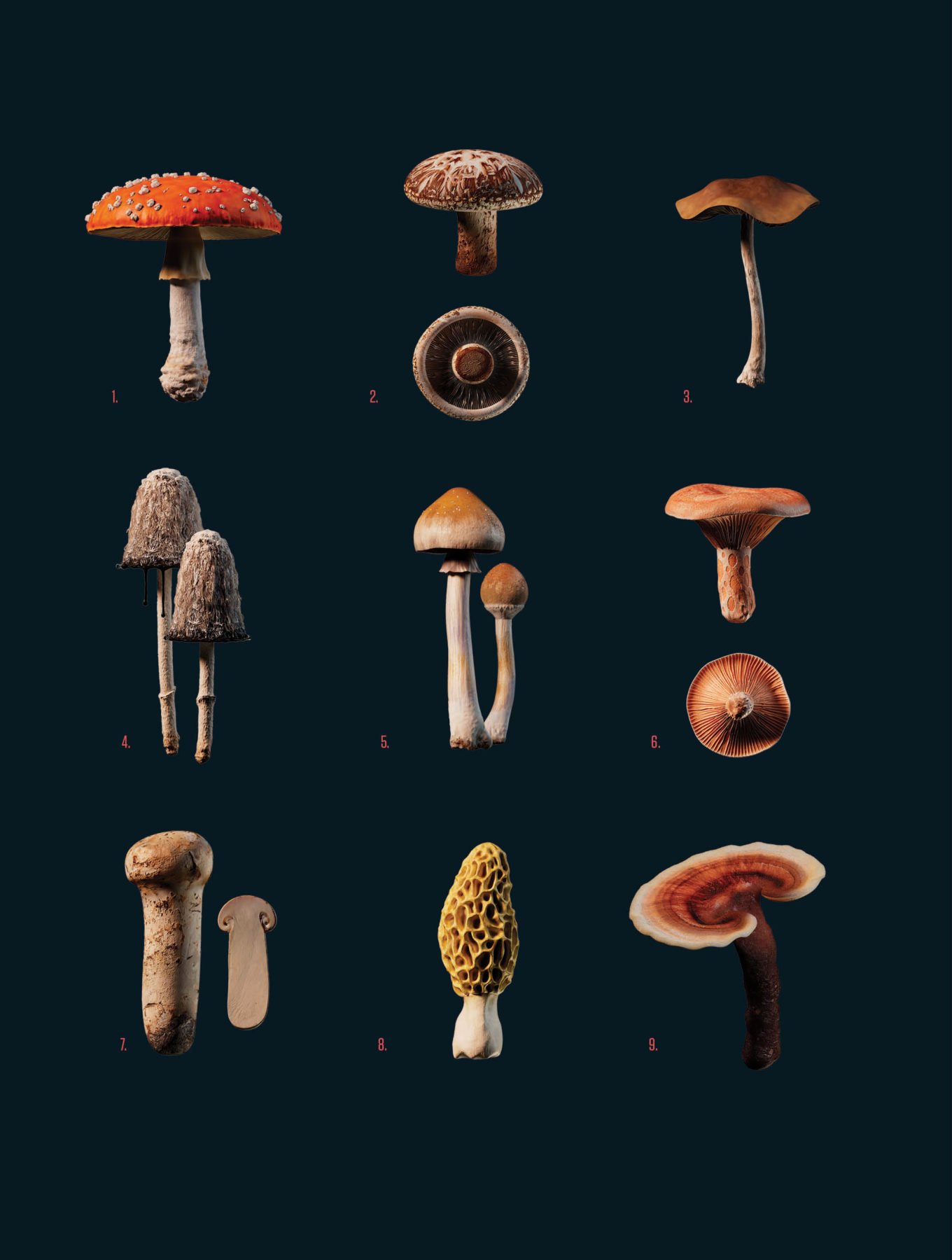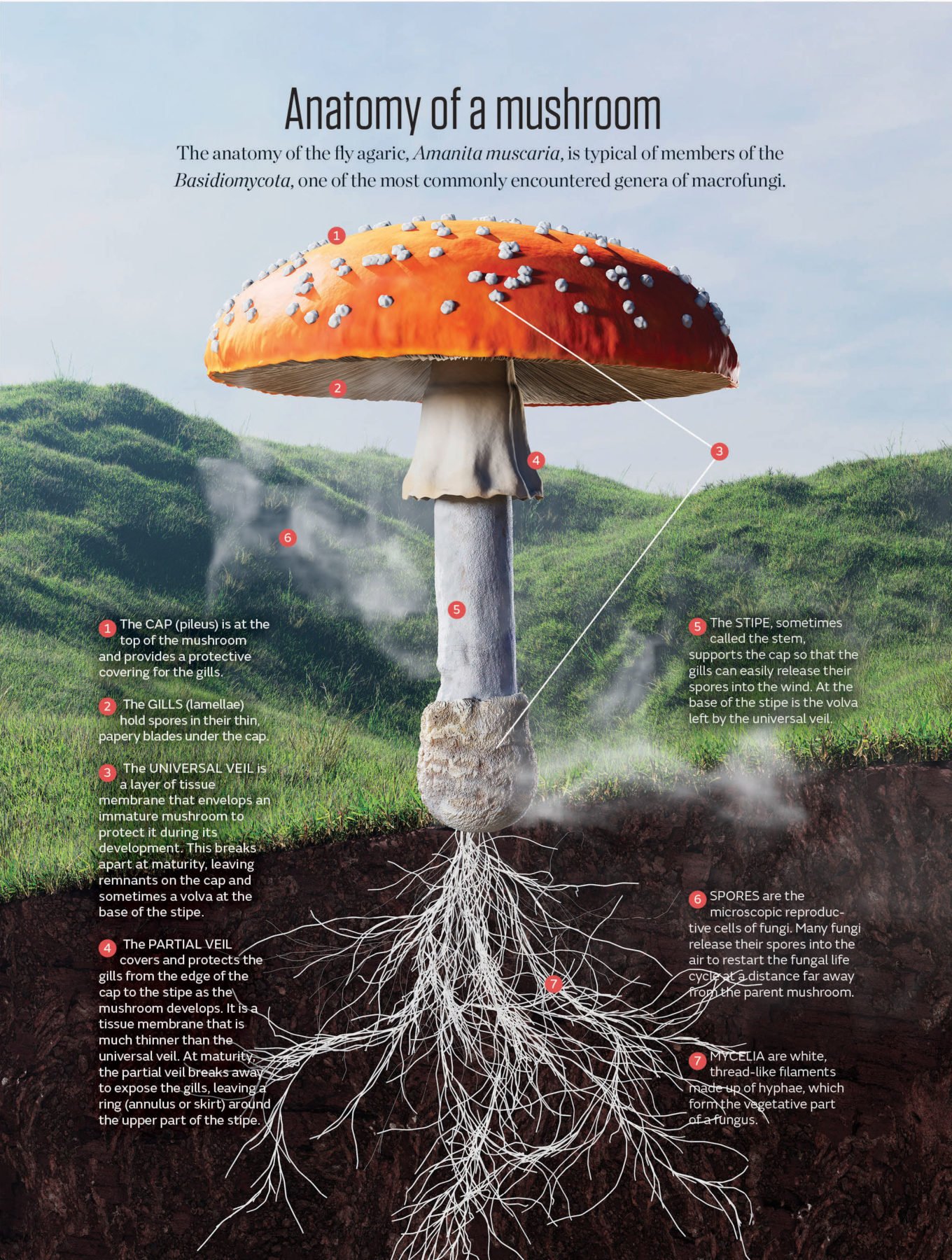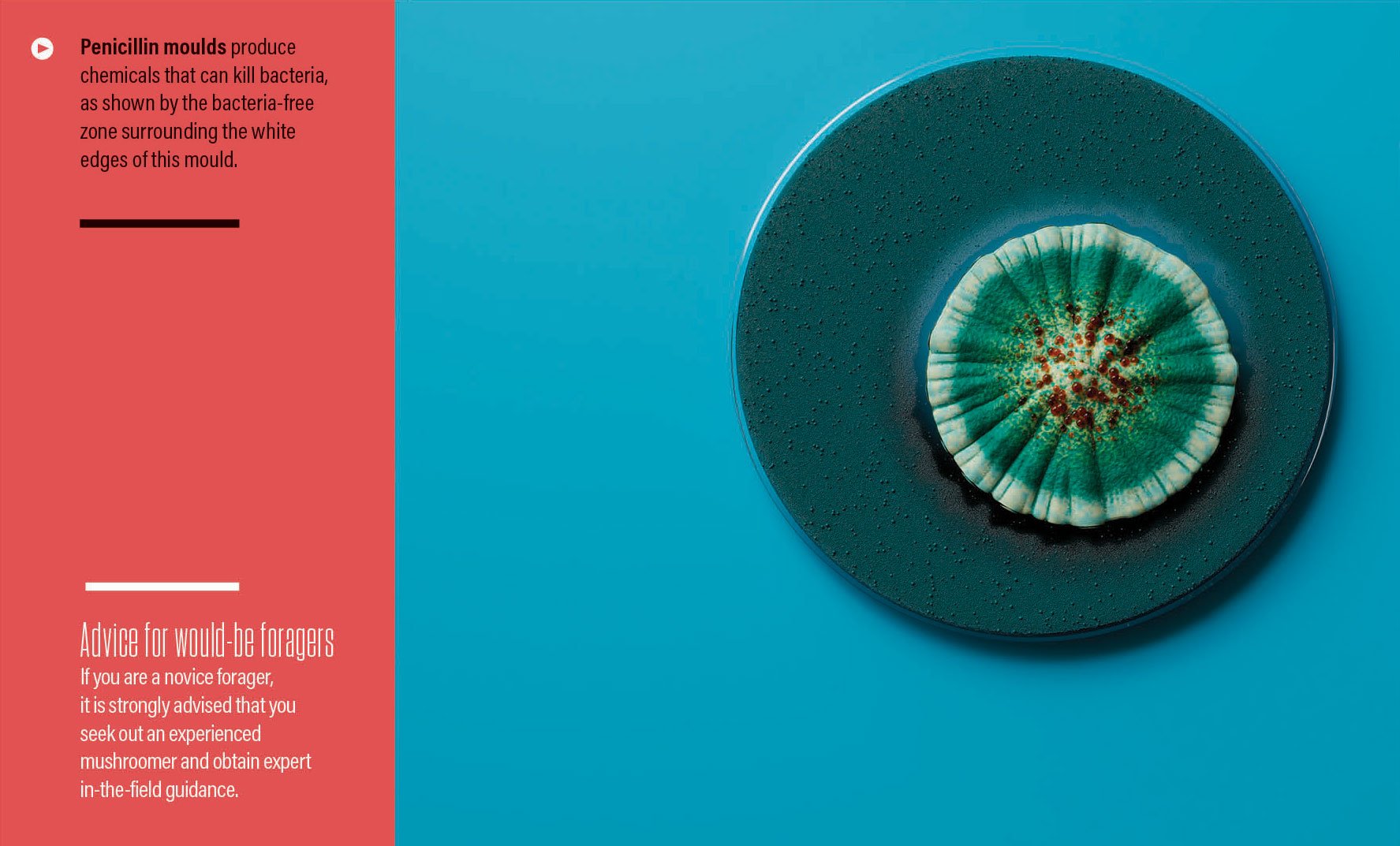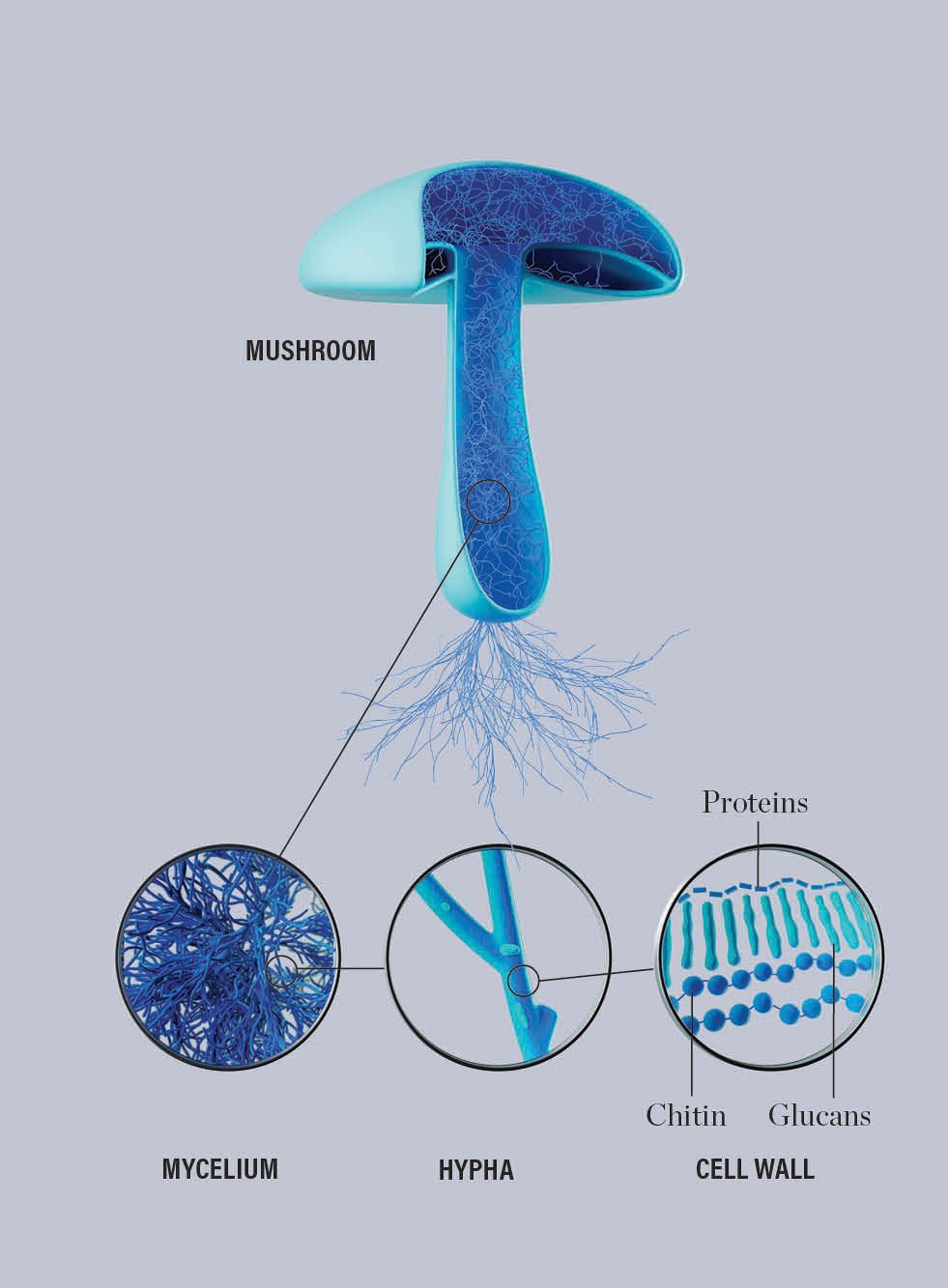WITHOUT FUNGI, THE world as we know it would not exist. Humans have harnessed the molecular powers of fungi since the beginning of civilisation, turning wheat into bread and fruit into wine, and our lives are richer for it.
Modern-day privileges such as chocolate, penicillin and detergent depend on fungi for their production. And one particular potent group contains psychoactive compounds that can transform experiences of love, creativity and connection. We are also learning to use fungi to transform organic matter into diverse and radical solutions for today’s urgent ecological and social issues.
Yet we know substantially less about fungi than we do about animals and plants. The kingdom Fungi classification was introduced in 1969 when ecologist Robert Harding Whittaker formalised the importance, scale and diversity of the group.
Previously, fungi were misclassified as plants and dismissed as something lower-class, tucked away in obscure corners of botany departments. To date, 120,000 species of fungi have been formally identified, but scientists estimate there are more than 6 million.
That means 98 per cent are still to be discovered, highlighting the untapped potential of the study of fungi – mycology.

Magic mushroom Psilocybe cubensis 6. Pine mushroom Lactarius deliciosus 7. Matsutake Tricholoma matsutake
Morel Morchella esculenta 9. Reishi Ganoderma lingzhi (Image credit: Joana Huguenin)
What are fungi?
The kingdom Fungi is incredibly diverse. Beyond the popular images of cap and stem mushrooms, there are clubs, corals, shells and balls, to name just a few.
Only 10 per cent of known fungi produce mushrooms. Yeasts, moulds and mildew are all fungi, yet most of these are invisible to the naked eye and don’t produce mushrooms at all.
Mushrooms themselves are just the tip of the metaphorical iceberg. They are simply the reproductive organs of an extensive fungal network. Thinking of fungi as only mushrooms is like thinking of people as only genitals.
Turn over a pile of leaves on a forest floor and you’ll almost certainly see white, furry patches hitched to the undersides of the fallen foliage. These white, cottony masses are mycelia, which are made up of individual strands of thread-like hyphae. Mycelia and hyphae are the growing and feeding parts of a fungus, typically existing within soils. They are most visible when they fuse and swell with water to produce mushrooms, which are recognisable, for example, as puffballs, morels or death caps.
Fungi encompass both mushrooms and mycelia. And although all mushrooms are fungi, not all fungi are mushrooms.
Mushrooms serve one biological function – reproduction. They contain spores, the reproductive units of fungi that function like seeds of plants. Fungi species that produce mushrooms for reproduction are macrofungi. The overwhelming majority don’t form sporing bodies, are called microfungi and, true to their name, their reproduction process is typically invisible to the naked eye.
Mycelium intelligence
Forests, grasslands and woodlands are not landscapes of individual trees competing with one another for survival. They are interconnected ecosystems that have formed over millions of years and their participants are able to negotiate, cooperate, trade, steal and compromise – all in the absence of a brain. Fungi connect them all. Underground mycelia weave a forest into a dynamic network of incredible scale.
Mycorrhizal fungi are networks of underground mycelium that interact – in a mutualistic relationship – with the root systems of plants. In exchange for sugars, they share nutrients such as nitrogen, phosphorus and carbon dioxide, and water with plants via their roots. Mycorrhizal fungi are the most widespread organisms in soil and up to 92 per cent of all land plants have an intimate relationship with such fungi.
These are far more complex than a single partnership between a fungus and a plant. Hundreds of mycelia can be attached to one plant and, conversely, one mycelium can be attached to hundreds of plants.
A single mycelium is so fine that a teaspoon of soil can hold hundreds of kilometres of them. And so an area such as a forest floor can be an elaborate information highway across which fungi and plants constantly relay resources and chemical signals.
It’s widely accepted that the carbon produced by one tree can be shared via its mycorrhizal partners with other trees. This was discovered by Dr Suzanne Simard, a professor of forest ecology at the University of British Columbia, and published in a 1997 paper in Nature. She called it the “wood wide web”. Today, that phrase is used to describe the mycelial highways that facilitate the transfer because they function like a forest’s organic internet.
Plants within the network can use it to transfer sugars, hormones, stress signals and carbon. Suzanne mapped mycorrhizal networks in numerous forests and found they were structured the same way as neural networks in the brain and node links within the internet.
The oldest and largest trees had the most mycorrhizal connections. Suzanne calls them “mother trees”. She believes they are social creatures that support the rest of the network by feeding seedlings and injured or shaded trees, warning others of attacks and transferring their nutrients to neighbouring plants before dying.
Not all scientists agree that fungi and trees operate from a place of altruism and cooperation. Dr Toby Kiers, a professor of evolutionary biology at Vrije Universiteit in Amsterdam, believes “both parties may benefit, but they also constantly struggle to maximise their individual pay-off”. Using market economics as a metaphor, Toby’s team published studies showing that plants and fungi trade under free market principles.
Some experiments showed that fungi hoarded nutrients in their mycelia to decrease supply. With increased demand from plants, fungi inflated “the price” for nutrients. The team also found that some plant species hijack mycelial networks and steal energy for survival.
This is the case for the ghost plant (Monotropa uniflora), a translucent white herb from the Americas that no longer produces green leaves to photosynthesise. In Toby’s work, capitalist fungi and plants display similarities to humans in their ability to manipulate the supply and demand of the forest market.
Fungi don’t, of course, possess intelligence in the form of a brain or centralised nervous system like those seen in animals. They have a series of nerve nets throughout the mycelia via which chemicals can travel, similar to our neural transmitters.
These chemical signals trigger responses that are programmed into their DNA, a type of intelligence that, in many cases, rivals the human brain in its degree of intricacy, complexity and connections.
Fungi are sentient, without thought; sophisticated, without cognition. It’s a fungal world, we’re just living in it.
Fungi can feed us
Humans are the only animals that cook, a process that uses chemical reactions to transform raw ingredients into a rich array of sensory pleasures. The study of food illuminates much about the society of a region, revealing its circumstances, values and beliefs.
Not long ago, the public image of mushrooms in Western culture was limited to sliced ornaments on pizza, a sauce for a pub steak or soup in a can. Their nutritional value was barely understood, and they were disregarded as a peripheral member of the vegetable grocery aisle.
We now know better. Neither plant nor animal, mushrooms belong to a distinct food kingdom. Every mushroom has a different nutritional profile, but all are filled with nutrients.
The mushroom is an ideal food because it is cholesterol-, sodium-, and gluten-free. Low in fats, sugars and calories and an excellent source of essential vitamins and minerals, it’s also rich in complex carbohydrates and dietary fibre – a true all-rounder.
Gourmet varieties carry more distinct and complex flavours than common button mushrooms. Once reserved for chefs, they are increasingly available for home cooks. In particular, oyster (Pleurotus ostreatus), king oyster (Pleurotus eryngii), brown beech (Hypsizygus tesselatus) and shiitake (Lentinula edodes) varieties have become more widely cultivated and sold in supermarkets. Growing these mushrooms at home is now easy and accessible.
Australia is a fungal haven. Its history of isolation from other continents and its ever-changing climate and nutrient-dense forests add to its diversity. If you’re in New South Wales, head to Oberon. You’ll find more than 40,000ha of pine forests that make it one of the country’s best mushroom-hunting grounds. Here, you’ll find the popular edible mushroom saffron milk cap (Lactarius deliciousus), which is said to have landed in Australia by accident, its mycelia attached to the roots of a tree imported from Europe. To find these mushrooms in Oberon, visit in autumn, from late February to May, when they proliferate.
We easily forget that our bodies and instincts were shaped by generations of foragers who lived in harmony with the natural world. Foraging is a unique activity in today’s digital world. It reconnects us with nature and is an unlearning of society. Instead of passively absorbing information, you actively peer into the forest to find fungi. Instead of excess, you take only what’s needed, leaving the rest for others. Instead of dulled senses, you hone the skill of noticing, taking in a mushroom’s body, earthy aroma and striking shape, texture, and colour.
A trip into a forest reconnects you with a broader ecosystem and is a reminder you are a part of – not outside – the web of life. A decaying tree trunk stops being an eyesore and becomes a place of opportunity: bracket fungi – wood decomposers that look like shelves – thrive there. Among dead leaves, on fallen trees, in grass or on cow dung – mushrooms grow everywhere.
It’s a moving meditation from which you learn about the natural world, and maybe even take home some free, delicious and nutritious food.

Fungi can heal us
Fungi are constantly in competition with microbes, insects and other animals, and, being immobile, can’t run from a threat. Their method of self-defence is to produce an array of complex chemicals that attack and destroy pathogens.
Fungi have had millions of years to develop their arsenal of chemical survival strategies and, fortunately for us, many of these strategies can be helpful in our fight for health. Compounds used by fungi to fight off pathogens have also proved effective in our bodies.
Penicillin, the world’s first antibiotic, is the most famous medicinal fungal product. Extracted from the mould Penicillium chrysogenum during World War II, it quickly became a frontline wonder drug. Some historians even credit the Allied victory to the miracle of penicillin.
The potential to find medically useful molecules from fungi species has expanded beyond antibacterial and into antifungal, antiparasitic and antiviral compounds. Other famous medicinal fungi include: Aspergillus terreus, from which drugs used to lower cholesterol are derived; Isaria sinclairii, the source of a multiple sclerosis treatment; and Tolypocladium inflatum, which has provided the immunosuppressant cyclosporin.
Beyond medical science, fungi have been used for thousands of years in traditional herbal medicine in the form
of medicinal mushrooms. Being a relatively accessible natural remedy with apparently few side effects makes medicinal mushrooms an attractive alternative to conventional treatments.
Compounds in mushrooms and mycelia are said to strengthen and regulate the immune system, stimulating the body’s self-healing potential. Some may even be able to attack malignant cells or microbes responsible for infections.
Most mushrooms, however, are best suited for preventative care, working with a functioning immune system to increase its defence systems and keep the body disease-free. Today, fungi permeate the health market in the form of powders, capsules, tinctures, drinks and even skincare.
Why might these be effective? Fungal cell walls are made up of chitin, the same structural component found in the exoskeletons of arthropods. These cell walls are rigid and inside them are long chains of complex carbohydrates called polysaccharides.
Fungi contain many types of beneficial polysaccharides, but most importantly the beta-glucans, notably (1-3),(1-6)-beta-D-glucan, for which animal studies have indicated even small doses may have beneficial effects on immune activity.
More than 20,000 published studies have shown beta-glucans generally to be a potent natural immune system–supporting force. They can stimulate weak immune systems and regulate overactive ones. They increase the body’s protection against bacterial, viral and parasitic infections, and offer a range of other synergistic health benefits.
Studies that tested for beta-glucan levels in mushrooms found the highest content in the species known as the turkey tail (Trametes versicolor) and reishi (Ganoderma lingzhi).
Our coevolution with fungi has left our bodies with receptor sites that can receive compounds that are found in fungi. As we evolved, we capitalised on the fact that fungi, microbes, plants and animals have different processes to produce molecules. We developed pattern recognition receptors that specifically bind to non-human compounds.
Picture a lock and key: when we consume beta-glucans, they fit into specific receptor sites in our immune system and activate our immune cells, which hunt for pathogens and cancerous cells in the body. Stimulating them encourages the body’s innate healing and defence responses.
This means medicinal mushrooms support nearly all the body’s major systems and allow you to perform at full potential.
There are currently a few thousand fungal genomes available for screening to discover new drugs for cancer or infectious diseases. Several new-generation pharmaceutical companies are already applying DNA sequencing, artificial intelligence and data science to fast-track fungal pharmaceutical discoveries.
Given that up to 6 million fungal species are available, these companies have an unparalleled amount of chemicals to review for prospective human medicinal use. This also highlights the urgency of conserving fungal biodiversity from which future medicines might emerge.
Fungi can free us
When humans consume certain species of fungi it can trigger altered states of consciousness, including some extraordinary changes in awareness, perception, cognition, emotions and mood. These changes create a psychedelic experience that transcends our physical reality, so descriptions of it are inevitably watered down. But the fact that we continue to try, through language, art and science, elucidates their spellbinding power on our psyche.
This psychedelic experience is due to a set of naturally occurring compounds in fungi that are psychoactive, meaning they interact with human pyschological functions.
Classic psychedelic compounds include mescaline, DMT, psilocybin and LSD. The latter two come from the Fungi kingdom.
Imagine that beneath the urgency of everyday life, there is boundless love, peace and connection dwelling in the depths of your being. Psychedelics offer us a glimpse into that possibility. These states of enlightened ecstasy were once only available to a fortunate few, but now they are accessible through a psilocybin mushroom or LSD experience.
Contrary to popular belief, psychedelics are safe when used properly. They can heal trauma, are naturally occurring, non-toxic and non-addictive. In modern history, psychedelics became intertwined with social movements and political motivations and were met with worldwide prohibition by the 1970s. Decades of opportunity to develop a culture that guides its citizens to use psychedelics in productive and useful ways have been lost.
But the light of psychedelics is flickering brightly once again. Dedicated researchers, doctors and advocates are paving the road to widespread acceptance by using legitimate scientific studies. The Australian federal government is funding $15 million in clinical trials for psychedelic research.
Psilocybin has reached phase II clinical trials in the USA. Psychedelic medicine companies are going public. The psychedelic renaissance is set for a massive boom; decriminalisation and legalisation movements are making great strides. This curiosity about the effects of psychedelics is also filtering through to the mainstream. Everyday people are turning to them to make sense of their existence – to find out who they are, who they are not and how they can recalibrate their lives.

Fungi can save our world
With the triple threats of climate change, resource depletion and waste build-up, a radical transformation of how we interact with nature is needed. Designers interested in the future of materials are taking inspiration from nature’s design systems and creating a circular economy of materials, grown, fabricated, used and, at the end of their life cycle, biodegraded or reused. Fungi are catalysts for this change.
Their natural design principles and manufacturing capabilities are being engineered in the upcoming biotechnology revolution. Using minimal energy, fungi can be engineered to produce high-performing materials with precision. Atom by atom, they can be used like a biological 3D printer to create new sustainable materials, freeing us from our reliance on extracting raw materials for energy and products and allowing us to use the inherent manufacturing capabilities of living organisms.

The future can be grown
The ever-adaptable mycelium is the core building block for the new biological materials revolution referred to as mycodesign and mycofabrication. Using mycelia, fungi can transform a range of waste into high-performing materials of almost any shape, strength and density. The process is energy- and resource-efficient.
Creating mycelium materials is a complex process, but here is a simplified description. To begin, substrates can be prepared using different types of organic waste, such as corn cobs, egg cartons or agricultural refuse. This is inoculated with spores of fungal strains that have been selected for their growth speed and compatibility with the substrate.
From there mycelia grow quickly, weaving and intertwining through the substrate. As the network of mycelia grows, it acts as a glue holding the substrate together, self-assembling into the shape of whatever container it sits in.
The starting materials convert into advanced biomaterials in less than two weeks. The new material thus created is then removed from the container and dried at the right temperature and humidity.
This process is one way that mycomaterials can take the form of flexible plastic-like sheets, garment materials or packaging. Depending on the type of substrate, fungal species used and custom-grow process, the properties of the material can change to suit different requirements and performance. For example, using heat pressing will strengthen and harden the composite material, causing the foamy structure to harden like wood. At the end of the material’s useful life, it is 100 per cent biodegradable and compostable.
A clear leader in the mycelium packaging space is a company called Ecovative, whose MycoComposite technology grows mycelium in a mould to create a custom structure called Mushroom Packaging.
In another notable development, California-based biotech company MycoWorks has created a fungi-based material that performs, feels and even smells like soft leather. Using its patented process and partnering with French luxury fashion house Hermès, it’s created a new mycelium material called Sylvania that debuted in the Fall–Winter 2021 collection in a new version of the classic Hermès Victoria bag.
Another producer of mycelium leather, using Ecovative’s MycoComposite technology, is Bolt Threads. In 2020 it unveiled a partnership with Kering, lululemon, adidas and Stella McCartney to collectively invest in, produce and launch Mylo products into the market in 2021.
A paradigm shift is occurring as more and more companies participate in the circular economy. The definition of waste is being rewritten as fungi is used to create new bio-based materials. Increasing awareness of these materials and their potential applications allows design with nature rather than against it. The pioneers of this believe we haven’t even scratched the surface of its potential applications.
Fungi provide enormous hope for saving our world. As we see more of it embedded into modern society, as packaging for online orders or replacing leather in garments, or as the building blocks of eco-friendly architectural projects, perhaps we’ll become more aware and appreciative of the immense kingdom that surrounds and supports us.
The Future is Fungi by Michael Lim and Yun Shu is published by Thames and Hudson.



